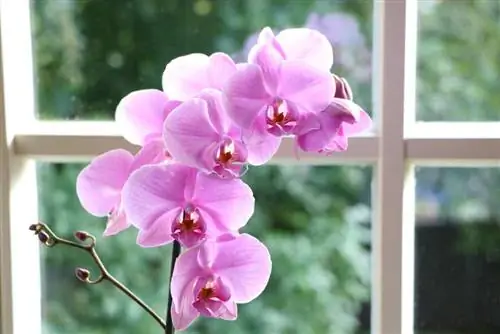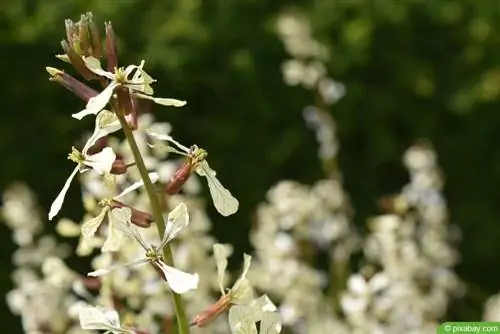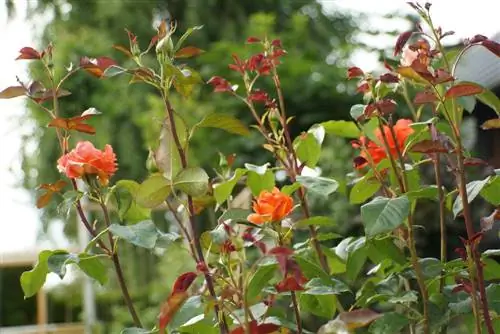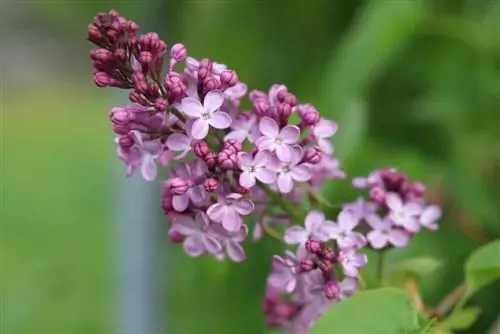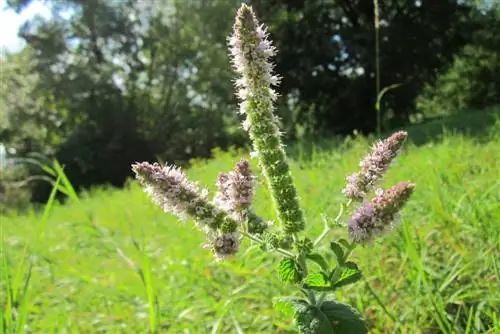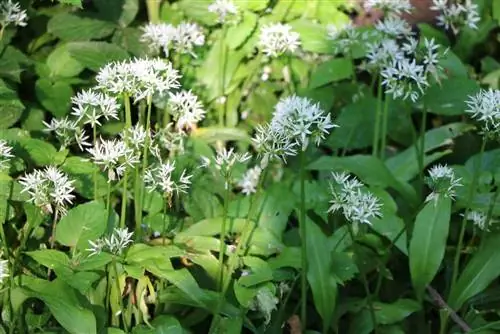- Author admin [email protected].
- Public 2023-12-17 03:39.
- Last modified 2025-06-01 06:48.
Bought in all its glory, many plant enthusiasts often quickly face the same problem: the orchid no longer blooms. Despite careful cultivation, buds simply no longer appear, although the orchid grows and thrives. The following tips show how to get it to bloom again.
Whether Phalaenopsis or Dendrobium - orchids present themselves in beautiful bloom when purchased, but in many cases remain colorless and bare afterwards. And that despite good care. For other hobby gardeners, however, they are almost ignored, but they always show their best side and are covered in countless flowers. Interested plant lovers can find out here where the causes of this can be found and how orchids can be helped to produce lush flowers again.
Failure to flower in Phalaenopsis
The Phalaenopsis is probably the best-known orchid, is often offered in supermarkets and is often given as a gift. The reasons for this lie in the fairly easy-care nature of the plants and the usually breathtaking flowers. However, it is not uncommon for Phalaenopsis to fail to bloom. If this is the case, the following factors should be checked:
- Location
- Pouring
- Fertilization
- Blend
The well-known orchid species does not require constant, complex care, but it only blooms under certain conditions. This also applies to other orchids that do not require winter rest.
Location
The Phalaenopsis wants light. And lots of it. However, you won't get any direct, strong sunlight. A location on the windowsill facing south is extremely unfavorable. In addition, temperature and its daily fluctuations as well as humidity play crucial roles if it is to be made to bloom again.
The location for the orchid is optimal if it looks like this:
- Windows facing east or west
- Temperature between 20 and 25°C
- Temperature fluctuations of a maximum of 2 °C during the day and between day and night
- As high humidity as possible, such as in the bathroom or kitchen
- Free from drafts
Of course, the right lighting conditions can also be created differently, for example by placing the orchid at some distance from the south window. However, if the air in the room is very dry or there are constant fluctuations, we recommend an indoor greenhouse or a glass dome, which acts as a damper and keeps the conditions approximately the same.
Pouring
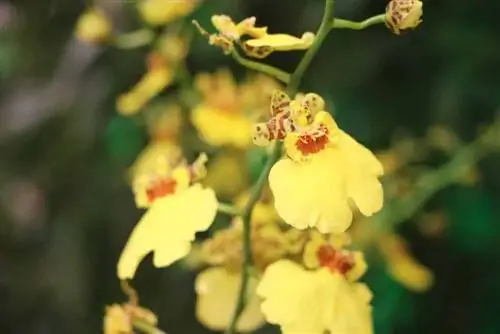
The orchid also wants a happy medium when it comes to watering. The Phalaenopsis wants it moist but definitely not wet. Due to the loose substrate, it is difficult to achieve this condition by ordinary watering. Often the water simply flows through and the root ends are exposed to waterlogging, while the substrate cannot soak up at all.
Instead, it is advisable to immerse the pot in water and leave it like that for about ten to thirty minutes. This allows the special substrate to become sufficiently saturated. The pot should then be allowed to drain to prevent waterlogging. It may take one to two weeks until the next watering, depending on the temperature. The soil should never dry out completely. Although the orchid will not die immediately, it will be stressed and will not produce any flowers.
In addition to watering with water that is as soft as possible, the Phalaenopsis should be sprayed every now and then. This measure is not necessary in rooms with already high humidity, such as the kitchen or bathroom, or in the indoor greenhouse. If the heating air is dry, you should use a sprayer every few days.
Fertilization
Since the Phalaenopsis is one of the orchid species that does not go into winter rest, it is cultivated throughout. The same care all year round also includes fertilizing the plant. The constant supply of nutrients also encourages renewed flowering.
Special orchid fertilizer is used, which is best administered directly via the irrigation water. Like watering, fertilization should be carried out weekly or every two weeks.
Blend
When it comes to Phalaenopsis, green parts of the plant should never be cut off. Even if a shoot has bloomed, it is left on the plant until it has completely dried out. There are two reasons for this. On the one hand, this type of orchid often forms new buds or a flowering side shoot on the same shoot. On the other hand, if green parts of the plant are removed, some energy reserves would be lost, which weakens the plant and makes it more difficult for new flowers to bloom.
So only the dried petals are removed, which can either be easily picked off or fall off on their own.
Tip:
If all of these measures are adhered to for Phalaenopsis and other orchid species without hibernation, they can bloom all year round and only take short breaks.
Other types of orchids
Although the Phalaenopsis is the best-known orchid species, it is by no means the only one. As great as the diversity is, so are the differences in culture. It is therefore crucial to know the species and its requirements in order to encourage the orchid to bloom again and again.
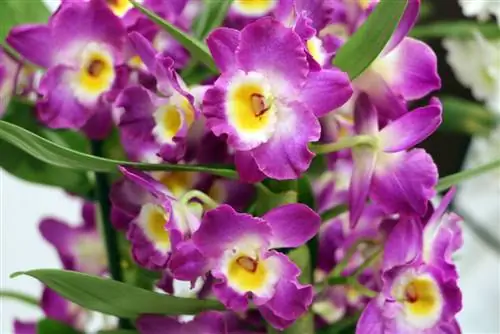
While the orchid species without hibernation can be treated in the same way as the Phalaenopsis, orchids with hibernation - such as the dendrobiums - require completely different care.
Tip:
If you ask when purchasing whether a rest period needs to be observed or not, you will save yourself the trouble of having to search for the requirements or identify the plant later. This is particularly important in view of the numerous hybrids that are now available in stores.
Location for orchids with hibernation
The orchid species that require winter rest also need a bright location without too much direct sun and with high humidity. However, temperatures can and should fluctuate. It is therefore advisable to move the location to a room that is heated during the day and ventilated at night - such as the bedroom. Hallways or a slightly shaded south side with strong temperature gradients are also favorable.
In summer, such orchids are allowed outside, be it on the balcony or in a light, shady spot in the garden.
Tip:
The orchids should be additionally shaded for two to three weeks after moving outdoors so that they can get used to the unfiltered sunlight and are not damaged.
Care
In order for winter-dormant orchids to be stimulated to bloom again, they need a clear difference between the growth and vegetation phases in their culture. Such species are also watered or dipped between spring and autumn. In winter, however, you only water sips or spray the substrate to prevent it from drying out completely. It's similar with fertilizing. Liquid orchid fertilizer is also used here, but this is only administered every four to eight weeks. In addition, there is no fertilization at all from September to February, as additional nutrients during this time would disrupt the vegetation phase.
Wintering
In order for the orchids to bloom again, they need a cool winter period. However, careful attention must be paid to the requirements and special features of the respective species. Although everyone wants to hibernate brightly and with winter sun, some prefer 15 to 20°C, others prefer 10°C. While the ideal temperatures vary depending on the species, there are similarities when it comes to winter care. As already mentioned, there is only little watering. So just enough water is poured so that the substrate does not dry out completely. Even better than watering is regular spraying of the roots and aerial roots with water, two to three times a week. From autumn onwards there will be no more fertilization. The additional nutrient supply is only resumed for the orchids in spring when renewed flowering is desired.
Control
Especially during winter dormancy, orchids are very susceptible to root rot because they can only absorb little moisture during this phase. Even if watering is carried out carefully, checks should be carried out at least weekly. The roots should be examined visually and, if suspected, by feeling for soft, muddy and greasy areas and deposits.
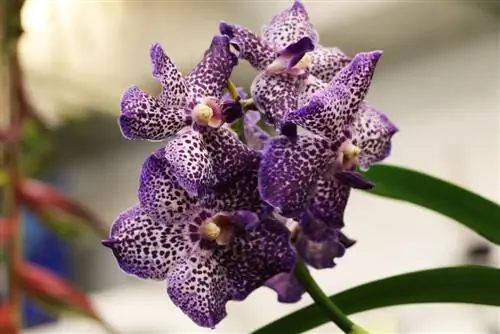
Any affected plant sections should be removed immediately. Anyone who neglects the controls should pay attention at the latest when children are increasingly being trained. Because these can be a clear indication of care errors.
Conclusion
Basically, it is not difficult to encourage orchids to bloom again. To do this, however, it is necessary to be precisely informed about the specific requirements of the respective species or at least to know whether the orchid needs hibernation or not. Only then is it possible to cause the orchid to bloom repeatedly - every year.
Tips coming soon
Natural Dives
Orchids especially like it when we treat them as naturally as possible. They love the root ball to be thoroughly moistened. This works well with a weekly dip in a bucket. Always use softened or rainwater.
Favorite place bathroom
Spraying and humidifiers can improve the microclimate. But the best thing is still a humid location in a bright bathroom, kitchen or winter garden.
Special substrate
Orchids die in normal potting soil. Their roots rely on airy plant materials that contain many coarse components such as nutrient-rich tree bark, chunks of peat or coconut chips. Special substrates are available from specialist retailers.
Repot now and then
Orchids should be repotted every two to four years. This happens when the substrate appears crumbly and drained. Remove rotten roots and old substrate, loosen the root ball and place it with fresh substrate either in the old pot or in a new, slightly larger pot.
Fertilize correctly
Orchid substrates usually contain small amounts of complete fertilizer with important trace elements. It makes sense to use liquid orchid fertilizer during the growing season from March to October. But only every third watering and never more than the manufacturer advises.
Lush blooms
The popular butterfly orchid has a particularly long flowering period. It can last up to four months per panicle. When the flowering is over, cut the stem down to the first or second thickening. After a short time, another inflorescence is formed from the nutrient reserves stored here.
Keep pests away
Indoor orchids are rarely attacked by pests or diseases. It is usually enough to ensure high humidity and to wipe the leaves every now and then with a damp cloth or rinse them under the tap. This keeps spider mites, aphids and scale insects in check.
Upright Standing
To prevent the flower spikes from breaking, they can be fixed to rods with clamps.

